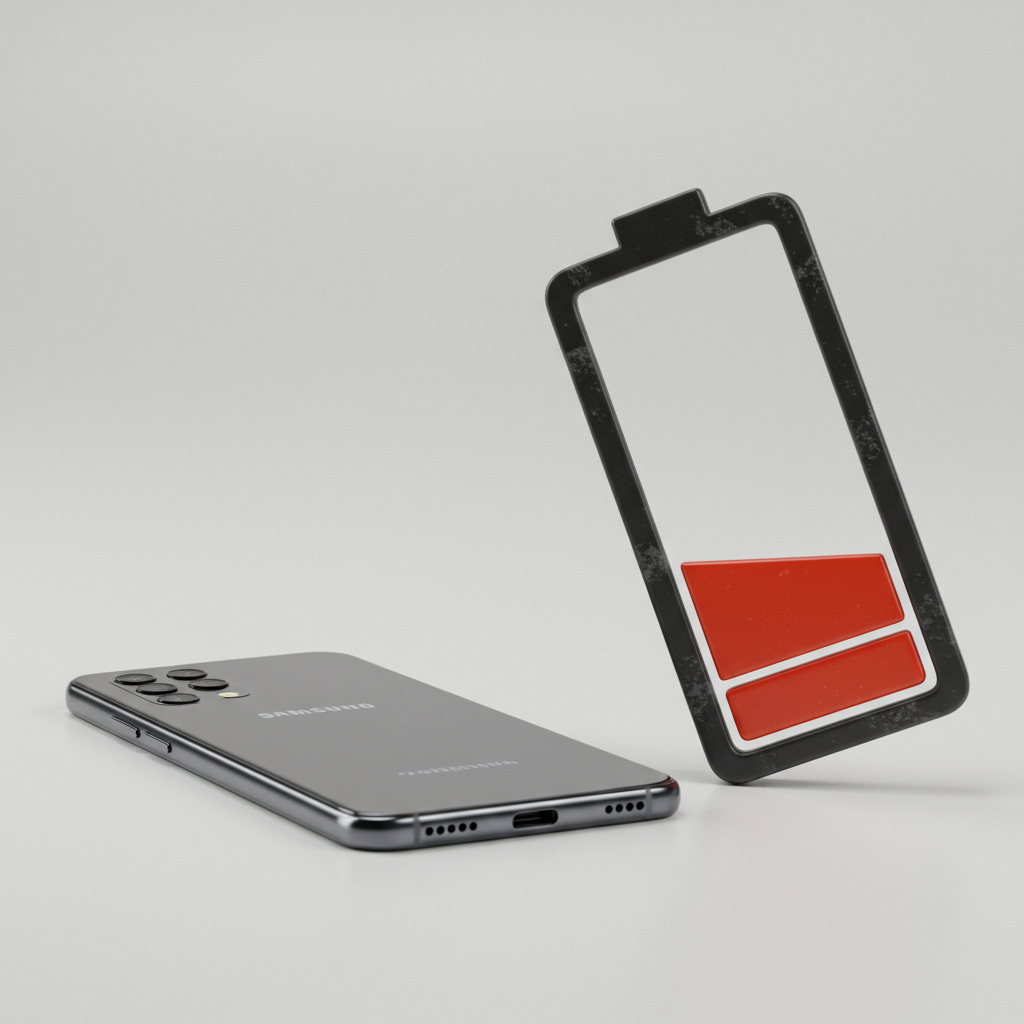Anticipation is building for Samsung’s next flagship series, the galaxy S26. While rumors suggest potential battery improvements, reports also hint at a significant risk: Samsung might prioritize a thinner design over a substantial increase in battery capacity. This strategic choice could lead to user disappointment and see Samsung fall further behind competitors already pushing the boundaries of mobile battery technology and capacity.
Potential New Battery Tech for Galaxy S26
Recent reports indicate Samsung is exploring innovative ways to enhance the Galaxy S26 battery. The focus appears to be a collaboration with South Korean firm ITM Semiconductor. This partnership reportedly centers on integrating advanced battery protection circuits using Epoxy Molding Compound (EMC) technology.
EMC technology works by adding a protective layer around key battery components. This layer helps shield the battery from moisture and reduces electrical interference from other parts within the phone. Crucially, EMC can also contribute to better heat management. Since heat is a major factor in battery degradation and performance issues, improved cooling could significantly extend the overall lifespan and durability of the battery, especially during demanding tasks like gaming or using fast chargers.
Another potential benefit of this advanced circuitry is reduced size. Smaller protection circuits could free up valuable internal space within the device. This newfound room could theoretically be used to accommodate a physically larger battery cell, leading to increased capacity. It could also potentially enable faster, safer charging speeds by improving how the battery handles power input and output.
The Core Concern: Capacity Stagnation
Despite the promising EMC tech rumors, the significant point of concern, as highlighted by industry observers, is what Samsung doesn’t appear to be planning. The current reports about the ITM Semiconductor partnership and EMC technology notably do not mention any corresponding increase in the battery’s mAh capacity for the standard Galaxy S26 model.
This lack of explicit capacity increase is sparking skepticism. Given Samsung’s recent history, where flagship battery capacities haven’t seen major jumps compared to some rivals, critics worry the company might leverage the smaller EMC circuits to simply make the phone thinner rather than adding a larger battery cell.
The prevailing fear is that Samsung might equip the Galaxy S26 with a battery size similar to its predecessor, potentially hovering around the ~3,900mAh mark seen in the Galaxy S25. While presenting the EMC tech as an “innovation” that enables a slimmer profile, this would sidestep the direct demand many users have for longer battery life achieved through raw capacity.
Prioritizing Thinness Over Longevity?
This potential decision to prioritize a “wasp waist” design over a larger battery cell seems to go against clear user preference signals. While a sleek design is appealing, countless user surveys and anecdotal feedback consistently place battery life among the top priorities for smartphone buyers.
The author of the original piece points to the alleged struggles of the Galaxy S25 Edge, a model reportedly focused on a thin profile, as possible evidence that the market isn’t prioritizing ultra-slimness above all else. Although this might be specific to that particular model, it serves as a cautionary tale. Users generally prefer a phone that lasts all day, even if it means a marginally thicker build.
Samsung has the opportunity with this new EMC tech to offer both enhanced battery durability and increased capacity. However, the current rumors suggest they may opt for a path that, while technically innovative, doesn’t deliver the most requested user benefit: simply having more power in the tank.
How Samsung’s Rivals Are Leading the Way
The skepticism around Samsung’s potential S26 battery strategy is amplified when looking at what competitors are achieving. Several Android manufacturers, along with Apple, are making significant strides in battery technology and capacity, setting higher benchmarks for flagship endurance.
Companies like OnePlus and Xiaomi have consistently offered phones with larger battery capacities than many Samsung flagships. Devices like the OnePlus 13 already feature substantial 6,000 mAh batteries. Furthermore, rumors suggest future models, such as the hypothetical OnePlus 15, could push capacity even further, potentially reaching 7,000 mAh.
Much of this progress is attributed to the adoption of advanced battery chemistry, specifically silicon-carbon technology. Silicon-carbon anodes allow battery cells to store more energy within the same physical volume and weight compared to traditional lithium-ion batteries. This enables manufacturers to pack significantly higher mAh ratings into relatively slim and standard-sized phone bodies, directly addressing the user need for longer power.
Even newer players are embracing these technologies. The Nothing Phone (3), positioned as a disruptor, is expected to feature a silicon-carbon battery with a capacity around 5,150 mAh, paired with relatively fast 65W charging. This demonstrates that achieving higher capacities with advanced tech is feasible for various manufacturers, regardless of scale.
Stagnation in Samsung’s Flagship Lineup?
This external innovation contrasts sharply with Samsung’s recent approach to battery capacity in its top-tier phones. The premium Galaxy S26 Ultra is rumored to inherit the same 5,000 mAh battery capacity that Samsung has included in its Ultra flagships since the Galaxy S20 Ultra debuted in 2020.
While a 5,000 mAh battery is by no means small and can deliver decent endurance, especially with software and chipset optimizations, maintaining the exact same capacity for six consecutive years raises questions about innovation velocity in this critical area. Compared to rivals rapidly increasing capacity, Samsung’s approach could be perceived as stagnant, potentially impacting its reputation for pushing boundaries.
The situation with other anticipated Samsung devices, like the foldable Galaxy Z Fold 7, also shows potential for battery capacity disappointment, with rumors suggesting a cell possibly less than 4,400 mAh.
Interestingly, even Apple, a company often perceived as prioritizing optimization over raw battery size, is rumored to be increasing capacity in its upcoming models. Leaks suggest the iPhone 17 Pro Max in 2025 could feature a 5,000 mAh battery cell. While not groundbreaking on its own, combined with Apple’s renowned software efficiency, this could translate to excellent real-world battery life, further closing the gap with Android competitors in raw capacity.
The Missed Opportunity
The availability of new tech like EMC and the existence of silicon-carbon battery solutions present a clear path forward for Samsung. The ideal scenario, as argued by critics, would be for Samsung to combine the durability and thermal benefits of EMC with a larger-capacity silicon-carbon cell.
This combination could result in a Galaxy S26 with significantly improved battery life and enhanced longevity, potentially setting a new standard for flagship endurance. Even if this meant the phone couldn’t be made dramatically thinner, many users would likely view this as a worthwhile trade-off for all-day or multi-day power.
Samsung’s perceived hesitation to embrace larger batteries, especially while competitors actively do so, is seen by some as a strategic misstep. With the Galaxy S26 still months away, there’s hope that future leaks might reveal a more ambitious battery plan that genuinely addresses user demand for sustained power, leveraging new technologies for capacity boosts, not just design tweaks.
Frequently Asked Questions
What new battery technology is rumored for the Samsung Galaxy S26?
The Galaxy S26 is rumored to potentially feature new battery protection circuits developed by ITM Semiconductor using Epoxy Molding Compound (EMC) technology. This tech aims to improve battery durability, lifespan, and heat management, which could allow for smaller circuit sizes and potentially free up internal space.
Should users expect a significant battery life boost from the standard Galaxy S26?
Based on current rumors, it’s uncertain. While the rumored EMC tech could improve battery lifespan and efficiency, reports do not mention a larger battery capacity compared to its predecessor (~3,900mAh). Critics fear Samsung might use space saved by the new tech to make the phone thinner instead of increasing the battery size, potentially limiting the real-world battery life improvement.
How does Samsung’s rumored battery approach compare to rivals like OnePlus or Apple?
Competitors like OnePlus are already using silicon-carbon battery technology to achieve capacities of 6,000 mAh or more in their flagships. Apple’s upcoming iPhone 17 Pro Max is also rumored to increase capacity to 5,000 mAh. This suggests rivals are prioritizing raw capacity alongside efficiency, while Samsung’s current S26 rumors focus on durability tech without confirmation of a needed capacity increase, potentially leaving them behind in total endurance.
Conclusion
The prospect of advanced battery technology in the Samsung Galaxy S26 is exciting, offering potential benefits in durability and thermal performance. However, the current speculation raises a critical question: will Samsung fully capitalize on this by finally increasing battery capacity? Or will the focus on device slimness mean a missed opportunity? With competitors aggressively pursuing higher mAh numbers and advanced battery chemistries like silicon-carbon, Samsung’s decision regarding the S26 battery capacity could be a pivotal point, determining whether its next flagship is celebrated for its endurance or criticized for falling short. The coming months may reveal whether Samsung will listen to user demand and deliver the substantial battery upgrade many are hoping for.




